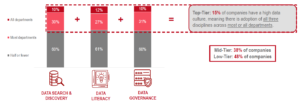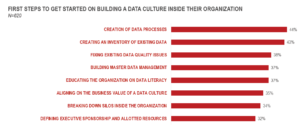
Data Culture Report: More Investment Needed, Alation Says

Organizations are beginning to realize how important building a sustainable data culture is to their on-going success and what it takes to get there, but they’re still not investing enough to actually build the data culture, according to Alation’s fourth State of Data Culture Report, which it unveiled today.
Alation has noted an interesting progression in organizations’ attitudes towards their own data cultures over the four installments of the State of Data Culture Report, which is conducted by Wakefield Research on behalf of the Silicon Valley data catalog company.
In the first report, Alation detected a bit of a Dunning-Kruger effect, where the individuals taking the survey rated their own organizations much higher on the three pillars of data culture–data search and discovery, data literacy, and data governance–than the evidence suggested they should.
There was some data culture progress spotted in the August 2021 report, which found a 22% increase in adoption of data literacy across all or most departments, a 15% increase in adoption of data search and discovery, and 14% increase in adoption of data governance.
But there has been some fall back in the new report, which is based on a survey of 620 data and analytics executives at organiztaions with 2,500 employees or more. The report found a 29% decline in the number of top-tier data organizations that show widespread competency in those data domains (meaning there’s widespread adoption of the three pillars of data culture across “most or all departments”).

Only 15% of survey-takers report having adoption of all three data culture discplines (Source: Alation State of Data Culture Report 2022)
The company speculated that this could be a sign of disruption from the Great Resignation, which has impacted data and analytics groups as hard as it has other departments. Satyen Sangani, the CEO and co-founder of Alation, suggests the decline is actually a sign of building maturity in the data culture department.
“To me, the bad news is the good news in the sense that…there is now a recognition of the problem,” Sangani tells Datanami. “To solve any problem, first you have to acknowledge you have it, and now we’re seeing these people are acknowledging that they have it.”
The findings suggest that people are recognizing that they don’t have a strong data culture yet, and that it’s also really hard to build one, says Sangani, a Datanami Person to Watch for 2022.
“What’s interesting is that there has a been a lot more maturity in this space, but the maturity shows up as people recognizing what ‘good’ really looks like, and now seeing that they don’t have it and aren’t getting there,” he continues.
A clear linkage surfaced in the report between having a strong data culture and organizational or business success. The report found that 90% of the organizations that rank near the top in terms of their data culture met or exceeded their revenue goals, with half of them exceeding those revenues goals.

Steps suggested by data leaders to build a data culture (Source: Alation State of Data Culture Report 2022)
That’s a good indication that investing in data works, Sangani says.
“I think we’d have to do a lot more work to establish causality,” he says, showing a bit of empirical prudence. “But the fact that these people have made these investments and the fact that there is a corresponding 10% return rate certainly is a great signal. And it means if you’re not investing in data, then the question becomes why? And what are you investing in? And how do you expect to maintain competitive differentiation over time?”
Unfortunately, the last part of the report brought some bad news. Despite the evidence suggesting a link between having a strong data culture and meeting or exceeding business goals, many organizations still are not making the necessary investments to build the data culture, the report finds. Alation calls it a “C-level strategy gap” when it comes to data investments.
In terms of data, the report found that 51% of survey-takers say they’re only going to get half of the data and analytics investment that they need. Only 18% of survey-takers say they’re going to get the full amount. Not surprisingly, top-tier organizations are more likely to be in that group.
The funding shortfall is a function of executives juggling competing investments, says Sangani, with a bit of economic shortsightedness thrown in for good measure.
“It’s a matter of prioritization. Every business goes through the exercise. ‘I want to put money into sales, I want to put money into marketing, I want to put money into data.’ Those are strategic choices that people make,” he says. “Even if there is clear evidence that is manifest and right in front of us [about] investing in knowledge systems, investing in training, investing in data, they are second-order investments.”
When you’re young, parents tell you to eat your vegetables because they’re good for you and they’ll make your body and mind healthier. Despite that knowledge, cheeseburger sales suggest people are not consuming the level of vegetables requisite with having a healthy mind and body.
Sangani suggests there’s a version of that dynamic occurring when it comes to data investments. “It’s not as big of a priority as the data suggest it ought to be,” he says.
You can download a copy of the State of Data Culture Report 2022 here.
Related Items:
Progress Spotted in Data Culture Development
Data Culture ‘Disconnect’ Identified in New Index
Alation Springs Into Data Governance



























